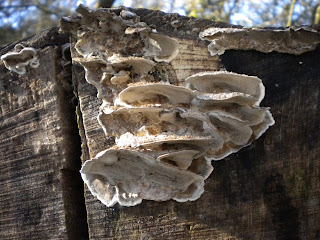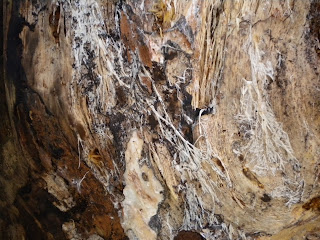On the way to the Pluck there were two things of note; one was a lichenised fungi, Cladonia pyxidata which is common everywhere and the other was Stereum hirsutum/Hairy Curtain Crust, an extremley common species of fungi. Below is Cladonia pyxidata...
Stereum hirsutum/Hairy Curtain Crust is generally found on living and dead wood of deciduous trees and shrubs; rarely conifers. The upper side of the fungi as the common name describes, is hairy with the underside smooth and bumpy.
Sadly, the Pluck is a fly tippers paradise and the sheer amount of rubbish thrown here is terrible..Inbetween binbags full of clothes and beercans all over the place I came across the remains of a huge beech tree that had been felled and on one large block there were a couple of mushrooms to be found. Below is a common species called a Smoky Bracket. Bjerkandera adusta.
The photo below shows the mycelium of an unknown fungus living off the the wood on the underside of bark
There were two bracket fungi that I could not identify (below). If I could have cut them off the tree I might have done so but for the moment I'll leave them alone.
Also here was Auricularia auricula-judae/Jelly Ear. Very common and widespread. The samples below had dried out somewhat and were slightly brittle and hard. Auricularia auricula-judae/Jelly Ear is not specific with beech but can be found on most deciduous trees.
Another common beech fungi is Hypoxylon fragiforme/Beech Woodwart. They begin life a pinkish colour and slowly redden until they turn reddish brown and finally black. The surface of the fruit body is pimply.
On my home I came across a tiny 'oysterling' mushroom. It belongs to the Crepidotus family and could be Crepidotus variabilis/Variable Oysterling but I cannot be sure.
 |
















No comments:
Post a Comment